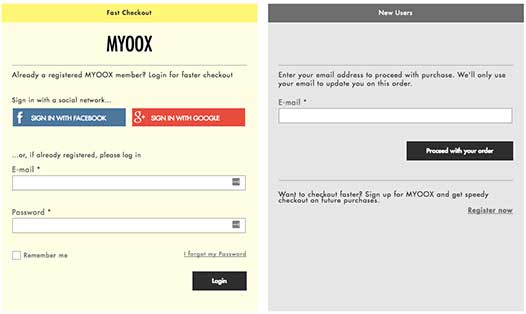An eCommerce site has only one goal: to sell! But the data speaks for itself: about 68% (source: Baymard) of eCommerce carts are abandoned while the total conversion rate is around 1.9%. This data tells only one thing: eCommerce sites lose a lot of money each day!
You can see why it is crucial to understand why customers so often abandon the cart and especially how important it is increase your conversion rates.
In essence, an online store does not differ much from what you can find in a brick and mortar location. We all expect a friendly greeting, product recommendations, no pressure from salespeople, and to find great deals. On the web there is no one to say “Hello, how may I help you?” We find the doors are wide open but no one is there to greet us with a smile.
Online shoppers are real customers and just as committed as a person in a storefront. Taking note of this awareness is the key strategy to increase conversions of an eCommerce site. Why? Because behind the screen of a computer, or a tablet, there are real people, flesh and blood, people who want to be treated as such, not as ATMs.
Here you create an eCommerce website thinking about real needs and expectations of its customers is the basis of every conversion. The smaller the gap between online sales and offline sales, the more you will increase your profits.
Getting to the point …
Are there any ways that can significantly improve conversion rates by a eCommerce website? Are there guidelines that can help identify and correct any errors that determine these poor results?
Yes!
Taking care of the user experience offered by the website and the entire sales process.
Many have realized that behind successful eCommerce websites there must be precise and accurate user experiences in design, making the process (in this case a sale) nice, simple and transparent.
Let’s take Amazon for example, one of the largest eCommerce websites in the world. Over the years Amazon has evolved its user experience by creating an online service that makes purchasing quick and easy. With the introduction of the button “Buy with one click” it doesn’t take much to realize how Amazon has the UX of its eCommerce users at heart.
That’s why it’s important to make your eCommerce website’s user experience a top priority. Below you can find the first 6 guidelines of 12 in a 2 part series that will help you to improve your eCommerce conversion rates significantly. Be on the lookout next week, when we cover the remaining 6 guidelines.
- Checkout process
- Shipping
- Optional Registration (guest checkout)
- Integrate reviews
- Page Load Speed
- Responsive Design
- Payment Alternatives
- User data
- Form Labels
- Trusts Badge
- Customer Care
- Cross-sell & amp; Up-sell
(and other factors to consider in Part 2 of the series)
1. Checkout process
The keyword here is simplify. The user expects a logical, linear sales process, just as they do in the offline sales process.
- I look for the article of interest to me
- I add it to the cart
- I take note of the price and any shipping costs
- I enter the data for delivery and payment
- I click on the “Checkout”
- Finally feedback confirming the order and a nice “thank you” never hurts either.
It is better to avoid complex and non logical steps. The checkout stage should always be lean and fast.
Tip: One of the best tricks of the sales process is the use of a progress bar. The progress bar confirms to the buyer that they are moving along correctly in the sales process.

2. Zero shipping costs
Another reason that causes potential buyers to abandon the cart are the high costs of shipping. People who buy on the web do it for two reasons: convenience and savings. The latter is influenced by shipping costs. If costs are excessively high or even similar to the cost of the item itself, it lacks the convenience factor, leading the user to abandon the purchase.
Tip: Whenever possible, it is good to offer free shipping on all items, or alternatively, you can create a threshold beyond which the shipments will be free.
3. Make registration optional (guest checkout)
One of the main causes (and perhaps #1) to shopping cart abandonment is forcing the buyer to register before making a purchase. Web users (myself included) do not like to provide their personal data for two reasons: First, because we do not want to create a new password to remember to buy only one or two products. Second, because very often we associate the word ‘registration’ with receiving newsletters, which in some cases, may even become spammy.
The solution to the problem is to make registration optional, offering the possibility to buy without the obligation to register (guest checkout) and postpone registration only at the conclusion of the sale. For example, via a pop-up maybe by encouraging the user with a discount on the next purchase.
Tip: Make it possible to register via a social login, a very popular solution, because with a simple click you avoid having to provide new data and makes the buying process even faster.
Here’s how Yoox has integrated social login buttons in its “Registration” page.

4. Integrate reviews
Time to confess… how often have you taken a look at reviews before purchasing? I imagine always (or most of the time). This is because the experience of those who purchased before can influence, positively or negatively, the sale, making it one of the factors that most often affects your conversion rate.
The other side of the coin is that automatically one is exposed to any criticism and discontent, but if the service offered is serious and professional, reviews can become even a great way to improve your branding.
5. Page load speed
If a web page takes more than 5-6 sec. to load, it is likely that the page will be abandoned, and in the case of a cart page, that means losing a sale. Optimizing page load times here is crucial to ensure a good user experience.
Tip: Choose carefully the hosting company to host your eCommerce website. Professional hosting is the basis of any optimization of loading times. For example, Aspen Grove Studios uses A2 Hosting which is one of the best hosting companies in the market that offers excellent performance at a very affordable cost.
6. Use responsive design
Responsive design is crucial for a simple reason: 35% of websites were accessed by smartphones and tablets in 2015, a 160% increase compared to 2014. This data proves how the mobile internet has become an integral part of any online business and in the life of each of us. That’s why your eCommerce store needs to be optimized for easy navigation, even on mobile.
Tip: It is good to assess with the client whether a responsive website can really be the best solution to increase the user experience offered by the site.
Example: In the case of un’eCommerce with a vast product catalog, have a responsive website may not be enough. While the creation of a dedicated mobile app can be the right choice.
In conclusion:
In this first of a two-part series, you read some of the most important factors that determine the conversion of an ecommerce store. In the next article I will talk about customer care, how to improve your forms to request data, and much more… stay tuned!
But now it’s your turn:
What have you done to improve your ecommerce conversions? What results did you get?
Please share in the comments!


Recent Comments